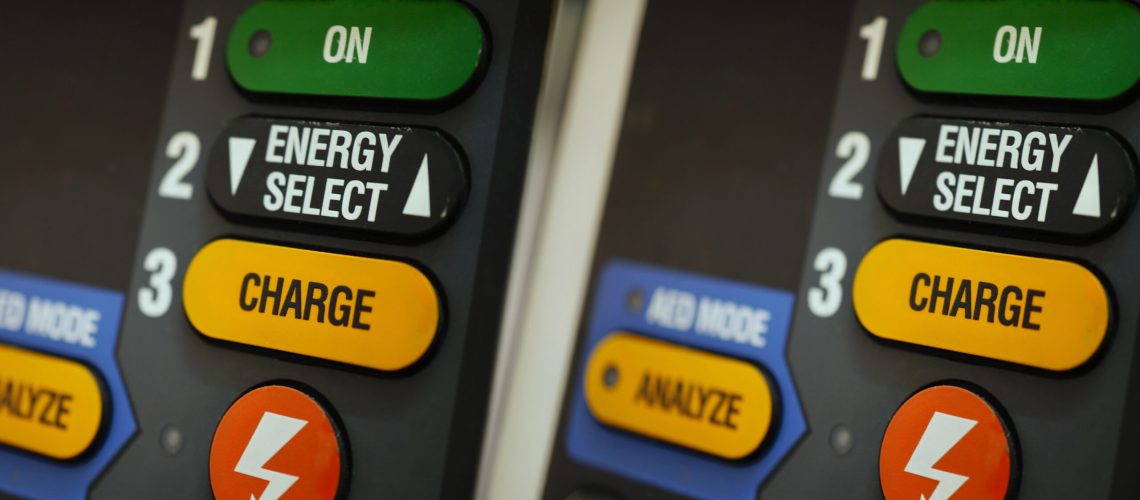Study Objective
The objective of this study (DOSE VF) was to evaluate the effectiveness of double sequential external defibrillation (DSED) and vector change (VC) defibrillation compared to standard defibrillation in patients with refractory ventricular fibrillation during out-of-hospital cardiac arrest.
Methodology
Study Design:
– 3-group cluster-randomized controlled trial with crossover
– Conducted in 6 paramedic services in Ontario, Canada
– Period: March 2018 to May 2022 (including a pilot phase from March 2018 to September 2019)
Population:
– Patients ≥ 18 years old in out-of-hospital cardiac arrest
– Refractory ventricular fibrillation presumed to be of cardiac origin
– Persistent ventricular fibrillation after 3 consecutive standard defibrillations
Randomization:
– At the level of paramedic services
– Crossover between the 3 groups every 6 months
Interventions:
- Standard defibrillation: continuation of shocks with electrodes in anterolateral position
- VC defibrillation: modification of electrode position to anteroposterior
- DSED: addition of a second pair of electrodes in anteroposterior position and delivery of 2 near-simultaneous shocks
Protocol:
– Resuscitation according to American Heart Association guidelines
– Rhythm analysis every 2 minutes
– Application of assigned intervention after 3 ineffective standard shocks
Outcome Measures:
– Primary: survival to hospital discharge
– Secondary:
- Termination of ventricular fibrillation
- Return of spontaneous circulation
- Good neurological outcome at hospital discharge (mRS score ≤ 2)
Statistical Analysis:
– Hypothesis: 8 percentage point improvement in survival with DSED and VC vs standard
– Power calculation: 310 patients per group (930 total) for 80% power (α = 0.05)
– Generalized linear models with adjustment for age, sex, and bystander CPR
– Intention-to-treat analyses and sensitivity analyses
Main Results
Population:
– 405 patients included: 136 in standard group, 144 in VC group, 125 in DSED group
– Mean age: 63.6 years, 84.4% male
– 67.9% witnessed cardiac arrests, 58% with bystander CPR
Primary Outcome:
– Survival to hospital discharge:
- DSED: 30.4% (38/125)
- VC: 21.7% (31/144)
- Standard: 13.3% (18/136)
– DSED vs Standard: Adjusted RR = 2.21 (95% CI: 1.33-3.67)
– VC vs Standard: Adjusted RR = 1.71 (95% CI: 1.01-2.88)
– Significant overall difference between the 3 groups (p = 0.009)
Secondary Outcomes:
- Termination of ventricular fibrillation:
– DSED: 84.0% vs Standard: 67.6% (RR = 1.25; 95% CI: 1.09-1.44)
– VC: 79.9% vs Standard: 67.6% (RR = 1.18; 95% CI: 1.03-1.36)
- Return of spontaneous circulation:
– DSED: 46.4% vs Standard: 26.5% (RR = 1.72; 95% CI: 1.22-2.42)
– VC: 35.4% vs Standard: 26.5% (RR = 1.39; 95% CI: 0.97-1.99)
- Good neurological outcome at hospital discharge:
– DSED: 27.4% vs Standard: 11.2% (RR = 2.21; 95% CI: 1.26-3.88)
– VC: 16.2% vs Standard: 11.2% (RR = 1.48; 95% CI: 0.81-2.71)
Authors’ Conclusions
- Survival to hospital discharge was significantly higher in patients who received DSED or VC defibrillation compared to standard defibrillation.
- DSED appears to be associated with better outcomes in terms of termination of ventricular fibrillation, return of spontaneous circulation, and good neurological outcome at hospital discharge.
- VC defibrillation could be a therapeutic alternative when a second defibrillator is not available to perform DSED.
- These results contrast with previous observational studies that had not shown a benefit of DSED or VC defibrillation.
- The effectiveness of these techniques could be explained by a change in the distribution of voltage gradients during the shock and/or an increase in delivered energy.
Implications for Clinical Practice
- DSED and VC defibrillation could be considered as alternatives to standard defibrillation in patients with refractory ventricular fibrillation during out-of-hospital cardiac arrest.
- DSED seems to offer the best results but requires the availability of a second defibrillator.
- VC defibrillation could be an interesting option when only one defibrillator is available.
- These techniques could be integrated into out-of-hospital cardiac arrest management protocols, particularly in urban areas where a second defibrillator is more often available.
- Specific training of paramedic teams would be necessary to implement these new defibrillation strategies.
Main Limitations of the Study
- Premature termination of the study due to the COVID-19 pandemic, not reaching the planned sample size.
- Possible overestimation of the treatment effect due to the small number of events for the primary outcome.
- Absence of a fixed follow-up time, with outcomes assessed until hospital discharge.
- Fragility of results for VC defibrillation (fragility index = 1 for the primary outcome).
- Impossibility of obtaining perfect adherence to the protocol in real-world paramedic practice conditions.
- Majority of patients included in urban settings, limiting generalization to more remote areas.
- Lack of information on patients’ ethnic characteristics, comorbidities, outpatient treatments, and in-hospital management.
- High level of medical supervision and feedback to paramedics, potentially difficult to reproduce in all services.
Full Study Reference
Cheskes S, Verbeek PR, Drennan IR, et al. Defibrillation Strategies for Refractory Ventricular Fibrillation. N Engl J Med. 2022;387(18):1686-1696. doi:10.1056/NEJMoa2207304
